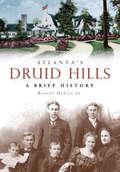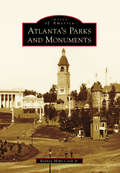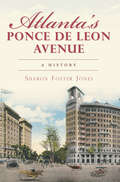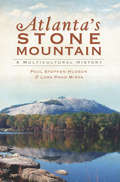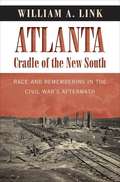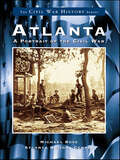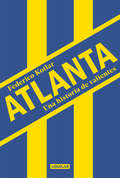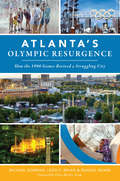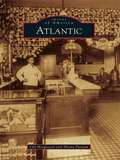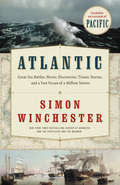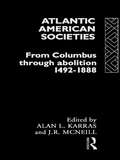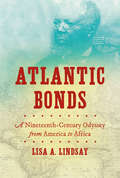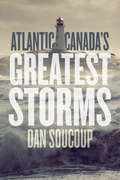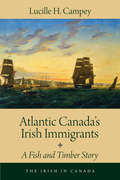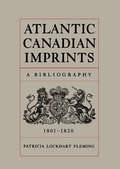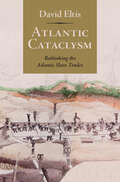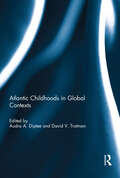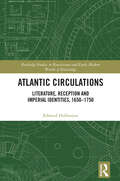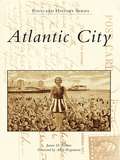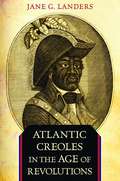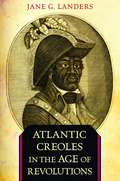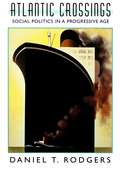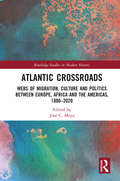- Table View
- List View
Atlanta's Druid Hills: A Brief History
by Robert Hartle Jr.The Druid Hills neighborhood is characterized by rolling hills, magnificent trees and shrubs and gorgeous, expansive houses. Its Ponce de Leon corridor bears the imprint of the founder of American landscape architecture, Frederick Law Olmsted. The brainchild of Joel Hurt, the neighborhood was brought to fruition by some of Atlanta's most prominent businessmen, including Asa Candler, founder of Coca-Cola. It was these movers and shakers of the city who lived in the neighborhood during the early decades of the twentieth century. In 1914, Druid Hills was permanently altered with the announcement that it would be the site of Emory University's new main campus. Now the residents coexist with what has become an international university community. Historian Robert Hartle Jr. has written an honest, impeccably researched tribute to Druid Hills, truly one of the jewels in Atlanta's crown.
Atlanta's Parks and Monuments
by Rodney Mims Cook Jr.Since the city's beginnings after the War of 1812, Atlanta has had a tradition of building with a regard for becoming a world-class metropolis. Before being burned by Union general William T. Sherman in 1864, the city's appearance was described by noted European architect and urban planner Leon Krier as "looking like London in the 18th century." Atlanta was surrounded by estates and plantations, and many of the plantation builders were influenced by Greek and Roman architecture. The argument of slavery to the contrary, builders saw Greek temples as symbols of democracy and, as a result, embraced Greek and Roman revival architecture as the dominant national style. Great monuments followed in this tradition to the letter in the capital of the South.
Atlanta's Ponce de Leon Avenue: A History (Brief History)
by Sharon Foster JonesNamed for the famous Spanish explorer who was said to have discovered the Fountain ofYouth, Atlanta's Ponce de Leon Avenue began as a simple country road that conveyed visitors to the healing springs that once bubbled along it. Now, few motorists realize that the avenue, one of Atlanta's major commuter thoroughfares, was a prestigious residential street inVictorian Atlanta, home to mayors and millionaires. An economic turn in the twentieth century transformed the avenue into a crime-ridden commercial corridor, but in recent years, Atlantans have rediscovered the street's venerable architecture and storied history. Join local historian Sharon Foster Jones on a vivid tour of the avenue--from picnics by the springs in hoopskirts and Atlanta Crackers baseball to the Fox Theatre and the days when Vivien Leigh, Clark Gable and Al Capone lodged in the esteemed hotels lining this magnificent avenue.
Atlanta's Stone Mountain: A Multicultural History
by Lora Pond Mirza Paul Stephen HudsonThe breathtaking geological wonder known as Stone Mountain has enchanted people since the age of the Paleo-Indians. Today, Stone Mountain Park annually attracts four million visitors from around the world. Hiking trails showcase rugged granite outcrops with hardy mountain plants, such as endearing yellow daisies. Majestic red-tailed hawks soar overhead. A storied past comes to life through an engaging park quarry exhibit, a historic railroad experience and an epic Confederate Memorial carving envisioned by Gutzon Borglum of Mount Rushmore fame. Writing during the 150th anniversary of the American Civil War, authors Paul Hudson and Lora Mirza of Georgia Perimeter College in Atlanta present with verve this illustrated multicultural history of a legendary landmark.
Atlanta, Cradle of the New South
by William A. LinkAfter conquering Atlanta in the summer of 1864 and occupying it for two months, Union forces laid waste to the city in November. William T. Sherman's invasion was a pivotal moment in the history of the South and Atlanta's rebuilding over the following fifty years came to represent the contested meaning of the Civil War itself. The war's aftermath brought contentious transition from Old South to New for whites and African Americans alike. Historian William Link argues that this struggle defined the broader meaning of the Civil War in the modern South, with no place embodying the region's past and future more clearly than Atlanta. Link frames the city as both exceptional--because of the incredible impact of the war there and the city's phoenix-like postwar rise--and as a model for other southern cities. He shows how, in spite of the violent reimposition of white supremacy, freedpeople in Atlanta built a cultural, economic, and political center that helped to define black America.
Atlanta: A Portrait of the Civil War (Civil War Series)
by Michael Rose Atlanta History CenterWhen the public envisions Atlanta during the Civil War, two primary images�of two unparalleled individuals�dominate: William Tecumseh Sherman and Scarlett O�Hara; however, there is more to the city�s Civil War heritage than a frowning general and a wily gentlewoman. Within the pages of Atlanta: A Portrait of the Civil War, discover the old city streets, period homes, and military fortifications of Atlanta in a number of rarely reproduced Civil War photographs. Taken from the Atlanta History Center�s visual arts collection, the images in this volume tell the story of the city as it was up to and during the Civil War. View the ruins of the Ponder House, the destruction of the rail lines, and the demolition of General Hood�s ordnance train. Informative captions complement this engaging collection of images, and include excerpts from diaries, letters, and memoirs regarding life in Atlanta during the war. Many of the photographs were taken by George N. Barnard and his staff during the Federal occupation of Atlanta in the fall of 1864, and again in 1866 as he planned a publication of war views. Atlanta: A Portrait of the Civil War offers a comprehensive view of the city during a war that continues to fascinate both professional and amateur historians alike.
Atlanta: Una historia de valientes
by Federico KotlarUna historia integral del Club Atlético Atlanta, hecha a partir de una profusa investigación periodística, con numerosas entrevistas y testimonios pero siempre desde el punto de vista afectivo de su autor, hincha de toda la vida. Incluye un par de textos invitados y un prólogo a cargo de uno de los seguidores más famosos y militantes del club, Sebastián Wainraich. No parece haber nadie más indicado que Federico Kotlar para escribir esta historia integral, completa, definitiva de Atlanta. Porque hace un recorrido cronológico que abarca todas las anécdotas y todos los datos que importan, y eso la convierte en el tesoro perfecto para varias generaciones -hijos, padres y abuelos- de corazones bohemios. Porque incluye testimonios que harán tambalear algunos mitos que parecían imbatibles -como el de la polémica final de 1985- y recorre el sinfín de conspiraciones que conforman el relato de glorias y desventuras del club. Pero por encima de todo, porque Federico es, además de un gran investigador, un auténtico hincha, uno que aprendió a lo largo de su vida a celebrar y, claro, a sufrir las vicisitudes de un equipo que siempre parece a punto de desaparecer pero que una y otra vez sale adelante con fuerza e instinto de supervivencia. Uno que nunca pierde el humor ni, como los hinchas más fieles, la esperanza de que este sea finalmente el año. «Veo deambular a Federico Kotlar hace años por la tribuna o por la platea de la cancha de Atlanta. De tanto vernos, algún día empezamos a hablar y surgió la relación entre dos tipos insoportables que en toda conversación siempre tienen algo para decir sobre el club. Alguna vez osamos dialogar sobre otras cuestiones, y encontré en Federico un hombre sensible, culto, periodista de raza, educado. Incluso parece un buen padre y un marido aceptable. De lo que estoy seguro es de que es un tipo generoso. A los hinchas de Atlanta nos regala este libro imperdible. Bien escrito, honesto, con historias y testimonios de un club entrañable que tratan de encontrar una respuesta a esta historia de valientes. Pero como en toda buena obra de arte, estas páginas nos van a dejar más preguntas que respuestas y a la vez nos van a hacer sentir acompañados en la locura. ¿Qué lleva a un ser humano a entregar horas de su vida a una cuestión que no deja de lastimarlo? Sean bienvenidos todos los hinchas del fútbol argentino a este libro. Pasen, lean y descubran qué es lo que sentimos los hinchas de Atlanta y por qué ser de Atlanta es distinto».Sebastián Wainraich «Lo bueno de las caídas es que dejan al desnudo lo más lindo que tiene el amor por un club: que no es un amor de usura. Y eso, en una época en la que nada parece ser gratis, creo que es algo muy valioso».Eduardo Sacheri «En el mundo capitalista siempre es preferible ganar, y las derrotas suelen conducir a la disolución de los perdedores. En la poesía, desde luego, no es así. Y el mundo está hecho de capitalismo pero también de poesía. Creo que hay algo de engrandecerse en la derrota, y en el sentido poético casi hay que celebrar las derrotas de Atlanta, un equipo que siempre me cayó muy simpático».Alejandro Dolina «Cuando era chico, el programa habitual de fin de semana con mi abuelo era caminar desde mi casa en La Paternal hasta la cancha de Atlanta para ver el partido. Cuando paso por ahí tengo siempre esa imagen, que para mí es de un tiempo de una cultura futbolística superior».Diego Latorre «Atlanta es un caso raro. No tiene ningún sentido que no haya sido campeón en Primera. Y tampoco que no haya tenido chances de estar en Primera en treinta años».Gonzalo Bonadeo
Atlanta’s Olympic Resurgence: How the 1996 Games Revived a Struggling City
by Michael Dobbins Leon S. Eplan Randal RoarkThe summer of 1996. In nineteen days, six million visitors jostled about in a southern city grappling with white flight, urban decay and the stifling legacy of Jim Crow. Six years earlier, a bold, audacious partnership of a strong mayor, enlightened business leaders and Atlanta's Black political leadership dared to bid on hosting the 1996 Olympic Games. Unexpectedly, the city won, an achievement that ignited a loose but robust coalition that worked collectively, if sometimes contentiously, to prepare the city and push it forward. This is a story of how once-struggling Atlanta leveraged the benefits of the Centennial Games to become a city of international prominence. This improbable rise from the ashes is told by three urban planning professionals who were at the center of the story.
Atlantic
by Shiona Putnam Lila HoogeveenThe history of Atlantic is rooted in the story of unrelenting entrepreneur Franklin H. Whitney. His passion inspired a strong and enterprising breed of men who embraced his vision and settled in the lush hills and valleys of Cass County, Iowa, in the decade following the close of the Civil War. The railroad provided the impetus for rapid growth and prosperity, and Whitney's vision of a new city became a reality when his recommendation for a depot site was approved. Within six days, Whitney's agent, Thomas Miller, had built the first house from which Whitney ordered furrows plowed to the railroad grading. Atlantic was thus born. The town grew rapidly, and by 1869 civic and social organizations, churches, newspapers, banks, schools, and businesses were thriving. Atlantic also had its share of shady characters, outlaw gangs, and disasters. The photographs and stories in this book provide a glimpse into the lives of Atlantic's intrepid developers and the city they established in the valley of the Nishnabotna.
Atlantic
by Simon WinchesterBlending history and anecdote, geography and reminiscence, science and exposition, the New York Times bestselling author of Krakatoa tells the breathtaking saga of the magnificent Atlantic Ocean, setting it against the backdrop of mankind's intellectual evolution Until a thousand years ago, no humans ventured into the Atlantic or imagined traversing its vast infinity. But once the first daring mariners successfully navigated to far shores-whether it was the Vikings, the Irish, the Chinese, Christopher Columbus in the north, or the Portuguese and the Spanish in the south-the Atlantic evolved in the world's growing consciousness of itself as an enclosed body of water bounded by the Americas to the West, and by Europe and Africa to the East. Atlantic is a biography of this immense space, of a sea which has defined and determined so much about the lives of the millions who live beside or near its tens of thousands of miles of coast. The Atlantic has been central to the ambitions of explorers, scientists and warriors, and it continues to affect our character, attitudes, and dreams. Poets to potentates, seers to sailors, fishermen to foresters-all have a relationship with this great body of blue-green sea and regard her as friend or foe, adversary or ally, depending on circumstance or fortune. Simon Winchester chronicles that relationship, making the Atlantic come vividly alive. Spanning from the earth's geological origins to the age of exploration, World War II battles to modern pollution, his narrative is epic and awe-inspiring.
Atlantic American Societies (Rewriting Histories)
by J. R. McNeill Alan L. KarrasWithin the chronological framework of Implantation, Maturation and Transition, this book provides the history of European expansion in the Americas from the age of Columbus through the abolition of slavery. Suggesting a shift in the traditional units of analysis away from nationally defined boundaries, this volume considers all of the Americas - and Africa - to encourage students to see the larger interimperial issues which governed behaviour in both the new world and the old. It also provides students with a mechanism for viewing interimperial rivalries from the largest possible perspective, by focusing, not only on commercial and demographic history and military and economic interaction between metropolitan regions and their colonies, but on the interdependence of European, African, and Amerindian peoples and culture.
Atlantic Bonds: A Nineteenth-Century Odyssey from America to Africa (H. Eugene and Lillian Youngs Lehman Series)
by Lisa A. LindsayA decade before the American Civil War, James Churchwill Vaughan (1828–1893) set out to fulfill his formerly enslaved father's dying wish that he should leave America to start a new life in Africa. Over the next forty years, Vaughan was taken captive, fought in African wars, built and rebuilt a livelihood, and led a revolt against white racism, finally becoming a successful merchant and the founder of a wealthy, educated, and politically active family. Tracing Vaughan's journey from South Carolina to Liberia to several parts of Yorubaland (present-day southwestern Nigeria), Lisa Lindsay documents this "free" man's struggle to find economic and political autonomy in an era when freedom was not clear and unhindered anywhere for people of African descent.In a tour de force of historical investigation on two continents, Lindsay tells a story of Vaughan's survival, prosperity, and activism against a seemingly endless series of obstacles. By following Vaughan's transatlantic journeys and comparing his experiences to those of his parents, contemporaries, and descendants in Nigeria and South Carolina, Lindsay reveals the expansive reach of slavery, the ambiguities of freedom, and the surprising ways that Africa, rather than America, offered new opportunities for people of African descent.
Atlantic Bonds: A Nineteenth-Century Odyssey from America to Africa (H. Eugene and Lillian Youngs Lehman Series)
by Lisa A. LindsayA decade before the American Civil War, James Churchwill Vaughan (1828–1893) set out to fulfill his formerly enslaved father's dying wish that he should leave America to start a new life in Africa. Over the next forty years, Vaughan was taken captive, fought in African wars, built and rebuilt a livelihood, and led a revolt against white racism, finally becoming a successful merchant and the founder of a wealthy, educated, and politically active family. Tracing Vaughan's journey from South Carolina to Liberia to several parts of Yorubaland (present-day southwestern Nigeria), Lisa Lindsay documents this "free" man's struggle to find economic and political autonomy in an era when freedom was not clear and unhindered anywhere for people of African descent. In a tour de force of historical investigation on two continents, Lindsay tells a story of Vaughan's survival, prosperity, and activism against a seemingly endless series of obstacles. By following Vaughan's transatlantic journeys and comparing his experiences to those of his parents, contemporaries, and descendants in Nigeria and South Carolina, Lindsay reveals the expansive reach of slavery, the ambiguities of freedom, and the surprising ways that Africa, rather than America, offered new opportunities for people of African descent.
Atlantic Canada's Greatest Storms
by Dan SoucoupA fascinating exploration of the most dramatic storms along Canada&’s Atlantic coast, from 1745&’s Grand Armada Tragedy to the 2017 Ice Storm. Over the centuries, Canada&’s Atlantic coast has been battered by hurricanes and winter blizzards, struck by tornadoes, devastated by floods, and even hit by terrifying tsunamis. Now Dan Soucoup, a historian of Canada&’s Maritime Provinces, explores the region&’s most dramatic storms from the 18th century into the 21st in Atlantic Canada&’s Greatest Storms. Soucoup chronicles the North Atlantic&’s greatest hurricanes, including the 1775 Independence Hurricane, the Saxby Gale in 1869, and Hurricane Igor in 2010. He also recounts a terrifying series of blizzards in 1905, The Year of the Deep Snow, which left passenger trains stranded for days in the Annapolis Valley; as well as Newfoundland&’s 1929 tsunami, which devastated the Burin Peninsula, striking dozens of coastal communities and carrying people and homes out to sea. Features 25 black and white images.
Atlantic Canada's Irish Immigrants: A Fish and Timber Story
by Lucille H. CampeyA transformative work that explodes assumptions about the importance of the Great Irish Potato Famine to Irish immigration. In this major study, Lucille Campey traces the relocation of around ninety thousand Irish people to their new homes in Atlantic Canada. She shatters the widespread misconception that the exodus was primarily driven by dire events in Ireland. The Irish immigration saga is not solely about what happened during the Great Potato Famine of the 1840s; it began a century earlier. Although they faced great privations and had to overcome many obstacles, the Irish actively sought the better life that Atlantic Canada offered. Far from being helpless exiles lacking in ambition who went lemming-like to wherever they were told to go, the Irish grabbed their opportunities and prospered in their new home. Campey gives these settlers a voice. Using wide-ranging documentary sources, she provides new insights about why the Irish left and considers why they chose their various locations in Nova Scotia, New Brunswick, Prince Edward Island, and Newfoundland. She highlights how, through their skills and energy, they benefitted themselves and contributed much to the development of Atlantic Canada. This is essential reading for anyone wishing to understand the history of the Irish exodus to North America and provides a mine of information useful to family historians.
Atlantic Canadian Imprints, 1801-1820: A Bibliography
by Patricia Lockhart FlemingThe first comprehensive analytical bibliography of Atlantic Canadian imprints, this volume covers some 320 books, pamphlets, broadsides, government publications, and serials. Most have not been listed before in any bibliography or catalogue. They represent the holdings of more than thirty libraries and archives in the four Atlantic provinces, and in Ontario, Quebec, the United States, and England. Each entry follows the principles of descriptive bibliography and includes full collation, contents, record of paper, type, and binding, analysis of issue and state, and location of every copy examined. Historical notes deal with authorship, printing, publishing, distribution and sales, and with the content of important works and the relationship between items. Arrangement is by province, then by year of publication. The material catalogued encompasses a wide range of subjects. God and government are two of the most common, but there are many others: education, municipal organization, history, elections, transportation, agriculture, legal trials, and a number of societies—benevolent, national, religious, and masonic. There are also many almanacs, including one in German, several satires and addresses in verse, and a French abécédaire. Not surprisingly in a nineteenth-century Maritime bibliography, signal books and decisions about piracy abound. Six indexes provide access by author, title, genre, trades, place of publication, and language. Patricia Fleming’s work continues Marie Tremaine’s A Bibliography of Canadian Imprints, 1751–1800 and supplements that work with new and previously unlocated imprints. It adds an essential element to our understanding of print communication in Atlantic Canada.
Atlantic Cataclysm: Rethinking the Atlantic Slave Trades
by David EltisIn this comprehensive work, David Eltis offers a two-thousand-year perspective on the trafficking of people, and boldly intervenes in the expansive discussions about slavery in the last half-century. Using new and underexplored data made available by slavevoyages.org, Eltis offers compelling explanations of why the slave trades began and why they ended, and in the process debunks long-held assumptions, including how bilateral rather than triangular voyages were the norm, and how the Portuguese rather than the British were the leading slave traders. Eltis argues that two-thirds of all enslaved people ended up in the Iberian Americas, where exports were most valuable throughout the slave trade era, and not in the Caribbean or the US. Tracing the mass involvement of people in the slave trade business from all parts of the Atlantic World, Eltis also examines the agency of Africans and their experiences in the aftermath of liberation.
Atlantic Childhoods in Global Contexts
by Audra A. Diptee and David V. TrotmanAtlantic Childhoods in Global Contexts explores childhood and youth in the Global South. The term childhood often conjures images of innocence, vulnerability and the need for protection, but this book suggests that, in colonial contexts, these images need to be re-examined. In fact, as the articles in this collection demonstrate, deviance, culpability, and a presumed autonomy were the more popular notions of childhood in the colonial context. These notions were held by the various actors in the colonial drama, not only colonial officials but interestingly enough often by the colonized people themselves. Furthermore, traditional notions of childhood as a period of total dependency are challenged in this collection, as the various authors explore the ways in which children were pro-active agents who shaped notions of childhood and therefore our understanding of the history of childhood.This collection provides in-depth analysis and offers new perspectives on how children were imagined and constructed (both legally and informally) in the colonial context. The contributions cover a broad geographic range that spans the Caribbean, Latin America, Africa, and India. Each of the authors explore the ways in which the interplay of Atlantic and Global influences shaped young people’s experiences, as well as the discourses that were used to articulate concerns about youth. The themes explored in this collection include the pathologization of childhood, juvenile delinquency, cultural creativity, and the use of child labour. The book ends with an interview by Sara Austin of World Vision Canada who discusses the ways in which the UN Convention on the Rights of the Child neglected to include the voices of children until 2014. This book was originally published as a special issue of Atlantic Studies: Global Currents.
Atlantic Circulations: Literature, Reception and Imperial Identities, 1650-1750 (Routledge Studies in Renaissance and Early Modern Worlds of Knowledge)
by Edward HolbertonAtlantic Circulations investigates literary conversations about empire in the British Atlantic world, c. 1650–1750. Reading texts by Anne Bradstreet, John Milton, Daniel Defoe, and Benjamin Franklin, as well as writing by overlooked authors who deserve more attention, such as the Quaker anti-slavery activist Benjamin Lay and the Black classicist Francis Williams, it asks how literary culture interacted with transatlantic debates about law, enslavement, economics, and religious freedom.This study explores the relationship between literature and empire by joining up disciplinary areas – Early Modern English Literature and Early American Literature – which are often considered apart. It develops insights and analytical frameworks from recent British and ‘Atlantic World’ history to argue that the transatlantic reception of literary texts was often shaped by ‘archipelagic’ dynamics: political and religious tensions between and within England and Wales, and Scotland and Ireland. Atlantic Circulations examines several previously unknown manuscripts and archives which throw new light on the circulation of literary texts in colonial culture and reconstructs key Anglophone transatlantic cultural debates during a crucial phase of European expansion in the Atlantic world.This book will appeal to advanced students and academic researchers of early modern and eighteenth-century English literature and British cultural history, especially readers with an interest in literature’s relationships with empire, colonialism, and travel, and scholars of early American literature and history.
Atlantic City
by James D. Ristine Allen PergamentAtlantic City was founded in 1854 and soon became a seaside resort surpassing all others, earning the nickname "Queen of Resorts." Chronicling the glory of the city from 1900 to 1930, these vintage postcards depict a time when visitors were eager to stroll on a local invention, the boardwalk; frolic on the beach; ride a rolling chair; and buy saltwater taffy. The annual Easter parade and Miss America Pageant became Atlantic City traditions.Amusement piers offered vaudeville, band concerts, thrill rides, diving horses, fishnet hauls, and more. Visitors stayed in grand hotels, among thelargest and finest in the world. Through more than 200 postcard images, the amazing spirit of this historic resort town is revealed.
Atlantic Creoles In The Age Of Revolutions
by Jane LandersSailing the tide of a tumultuous era of Atlantic revolutions, a remarkable group of African-born and African-descended individuals transformed themselves from slaves into active agents of their lives and times. Through prodigious archival research, Jane Landers radically alters our vision of the breadth and extent of the Age of Revolution, and our understanding of its actors.
Atlantic Creoles in the Age of Revolutions
by Jane G. LandersSailing the tide of a tumultuous era of Atlantic revolutions, a remarkable group of African-born and African-descended individuals transformed themselves from slaves into active agents of their lives and times. Big Prince Whitten, the black Seminole Abraham, and General Georges Biassou were “Atlantic creoles,” Africans who found their way to freedom by actively engaging in the most important political events of their day. These men and women of diverse ethnic backgrounds, who were fluent in multiple languages and familiar with African, American, and European cultures, migrated across the new world’s imperial boundaries in search of freedom and a safe haven. Yet, until now, their extraordinary lives and exploits have been hidden from posterity. Through prodigious archival research, Jane Landers radically alters our vision of the breadth and extent of the Age of Revolution, and our understanding of its actors. Whereas Africans in the Atlantic world are traditionally seen as destined for the slave market and plantation labor, Landers reconstructs the lives of unique individuals who managed to move purposefully through French, Spanish, and English colonies, and through Indian territory, in the unstable century between 1750 and 1850. Mobile and adaptive, they shifted allegiances and identities depending on which political leader or program offered the greatest possibility for freedom. Whether fighting for the King of Kongo, England, France, or Spain, or for the Muskogee and Seminole chiefs, their thirst for freedom helped to shape the course of the Atlantic revolutions and to enrich the history of revolutionary lives in all times.
Atlantic Crossings: Social Politics in a Progressive Age
by Daniel T. Rodgers"The most belated of nations," Theodore Roosevelt called his country during the workmen's compensation fight in 1907. Earlier reformers, progressives of his day, and later New Dealers lamented the nation's resistance to models abroad for correctives to the backwardness of American social politics. Atlantic Crossings is the first major account of the vibrant international network that they constructed--so often obscured by notions of American exceptionalism--and of its profound impact on the United States from the 1870s through 1945. On a narrative canvas that sweeps across Europe and the United States, Daniel Rodgers retells the story of the classic era of efforts to repair the damages of unbridled capitalism. He reveals the forgotten international roots of such innovations as city planning, rural cooperatives, modernist architecture for public housing, and social insurance, among other reforms. From small beginnings to reconstructions of the new great cities and rural life, and to the wide-ranging mechanics of social security for working people, Rodgers finds the interconnections, adaptations, exchanges, and even rivalries in the Atlantic region's social planning. He uncovers the immense diffusion of talent, ideas, and action that were breathtaking in their range and impact. The scope of Atlantic Crossings is vast and peopled with the reformers, university men and women, new experts, bureaucrats, politicians, and gifted amateurs. This long durée of contemporary social policy encompassed fierce debate, new conceptions of the role of the state, an acceptance of the importance of expertise in making government policy, and a recognition of a shared destiny in a newly created world.
Atlantic Crossroads in Lisbon’s New Golden Age, 1668–1750 (Iberian Encounter and Exchange, 475–1755)
by Cacey Bowen FarnsworthLong dependent on the Asian spice trade, Portugal suffered serious setbacks during the period of political union with Spain (1580–1640), as the Dutch and others seized key regions and destroyed commercial monopolies. By 1668, the greatest hope for a renewed Portuguese empire lay to the west. This book examines the “Atlanticization” of Lisbon during the early modern era, investigating the social, economic, religious, and political evolution that took place in Portugal’s capital during a period of upheaval and transformation in Europe and in the Atlantic world.In this book, Cacey Bowen Farnsworth shows how, between 1668 and 1750, Lisbon became a crossroads where colonial developments intermingled with metropolitan and global influences to produce something novel among European port capitals. Drawing from extensive primary and secondary sources from Portugal, Brazil, England, France, and Spain, Farnsworth lays out how Lisbon’s transformations were generated in commercial exchanges, especially the slave trade, as well as in the often-tense arrangements between the British and the Portuguese, and he shows how social, economic, cultural, and religious transformations made Lisbon a unique center of encounter.Responding to valid criticisms of Atlantic history, Farnsworth’s history of early modern Lisbon demonstrates that historians do not always have to defer to a global lens of analysis. It is sure to be of value to any researcher interested in early modern Iberia, commerce, and globalism.
Atlantic Crossroads: Webs of Migration, Culture and Politics between Europe, Africa and the Americas, 1800–2020 (Routledge Studies in Modern History)
by José C. MoyaUnlike most books on the Atlantic that associate its history with European colonialism and thus end in 1800, this volume demonstrates that the Atlantic connections not only outlasted colonialism, they also reached unprecedented levels in postcolonial times, when the Atlantic truly became the world’s major crossroads and dominant economy. Twice as many Europeans entered New York, Buenos Aires, and São Paulo in 3 years on the eve of WWI as had arrived in all the New World during 300 years of colonial rule. Transatlantic ties surged again with mass movements from the West Indies, Latin America, and Africa to North America and Western Europe from the 1960s to the present. As befits a transnational subject, the 24 contributors in this volume come from 14 different countries. Over half of the chapters are co-authored, an exceptional level of scholarly collaboration, and all but two are explicitly comparative. Comparisons include Congo and Yoruba slaves in Brazil, Irish and Italian mercenaries and adventurers in the New World, German Lutherans in Canada and Argentina, Spanish laborers in Algeria and Cuba, the diasporic nationalism of ethnic groups without nation states, and the transatlantic politics of fascism and anti-fascism in the interwar. Overall, the volume shows the Atlantic World’s distinctiveness rested not on the level or persistence of colonial control but on the density and longevity of human migrations and the resulting high levels of social and cultural contact, circulation, connection, and mixing. This title will appeal to students and researchers in the fields of Atantic and global history, migration, diaspora, slavery, ethnicity, nationalism, citizenship, politics, anthropology, and area studies.
